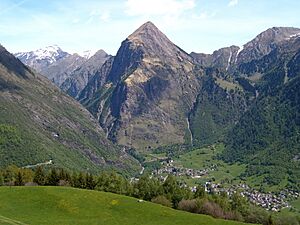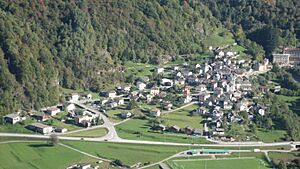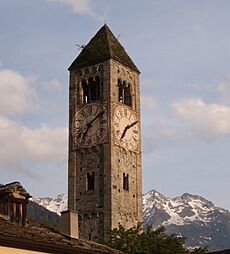Blenio facts for kids
Quick facts for kids
Blenio
|
||
|---|---|---|
 |
||
|
||
| Country | Switzerland | |
| Canton | Ticino | |
| District | Blenio | |
| Area | ||
| • Total | 202 km2 (78 sq mi) | |
| Elevation | 902 m (2,959 ft) | |
| Population
(Dec 2020 )
|
||
| • Total | 1,770 | |
| • Density | 8.76/km2 (22.69/sq mi) | |
| Postal code |
6718
|
|
| Localities | Aquila, Campo Blenio, Dandrio, Ghirone, Olivone and Torre | |
| Surrounded by | Malvaglia, Acquarossa, Faido, Campello, Calpiogna, Mairengo, Osco, Quinto, Medel (Lucmagn) (GR), Vrin (GR), Vals (GR), Hinterrhein (GR) | |
Blenio is a town, also called a municipality, located in the Blenio district of the Ticino canton in Switzerland. It was formed on October 22, 2006. Blenio was created by combining five smaller towns from the upper Blenio valley. These towns were Aquila, Campo Blenio, Ghirone, Olivone, and Torre.
One of the towns, Aquila, tried to stop the merger in court. However, the Federal Court decided on April 18, 2006, that the merger could go ahead.
Contents
History of Blenio
The towns that make up Blenio have a long history. Aquila was first mentioned in records in 1196. Ghirone appeared in records around 1200. Olivone was first noted in 1193 and later in 1205. In the Romansh language, Olivone was known as Luorscha.
Aquila's Past
Around the year 1200, the area of Ghirone was part of Aquila. The current borders of Aquila were set in 1853. This happened when Aquila and Ghirone finally became separate towns. The main church, San Vittore, was built in 1213. It was rebuilt later, between 1728 and 1730.
Many people from Aquila moved to other European countries to work. They often worked as chocolate makers, waiters, or servants. They would send money back home, which was a big help for the town. Starting in 1914, many residents also worked at the Cima-Norma chocolate factory in Torre. People also farmed and raised animals. When the factory closed in 1968, many people left Aquila. By 1990, about 39% of people worked in factories, and 49% worked in services. About 60% of workers traveled outside the village for their jobs.
Ghirone's Story
In 1334, the Disentis Abbey gained control over land in Ghirone. The village was once part of Aquila. In 1803, Ghirone officially joined the municipality of Ghirone. Later, in 1836, Buttino and Ghirone separated from Aquila to form their own community. Buttino was a separate village since the 1200s and had people living there until the late 1800s.
Ghirone and Buttino rejoined Aquila in 1842 and 1846. They finally became separate again in 1853. The Citizens Community, called Patriziato, was formed in 1914. It is still known as Ghirone-Buttino.
The Church of SS Martino e Giorgio was first mentioned in 1215. It was rebuilt around 1700. The church became independent from Aquila in 1758. Like other towns in the Blenio Valley, many people from Ghirone moved away to work. They often roasted chestnuts or worked as servants and waiters in other European countries. This brought money back but also caused the population to shrink.
In the late 1950s, the Luzzone Dam was built between Ghirone and Aquila. This dam creates hydroelectric power. The building of the dam and a new road tunnel in 1958 helped the local economy. The tunnel made it easier for tourists to visit in winter and summer. A new winter sports center, shared with Campo Blenio, also boosted the economy. However, animal farming, which was once the main job, became much less common.
Olivone's History
Powerful families, like the De Torre family, once controlled the upper Blenio valley. They owned land in Olivone and had rights over the main church. But in 1182, an agreement called the oath of Torre ended their power. In 1213, Olivone and Aquila joined together to fight against the Da Locarno family. The Da Locarno family had been given power over the valley by priests from Milan. The towns managed to drive them out. They returned to being ruled by a governor from Lombardy.
An assembly of free men, first mentioned in 1136, managed shared forests and pastures. They also helped maintain the Lukmanier Pass and Greina passes. By the late 1300s, this assembly also managed the Santa Maria alpine pasture. This pasture belonged to the Disentis Abbey. The town's local laws were written down in 1237 and 1474.
During the early Middle Ages, Olivone was likely the main religious center for the whole valley. Later, its history followed the same path as the rest of the valley. The main church, S. Martino, was built before 1136. It was rebuilt in the 1600s and renovated again in 1974 and 1984–91. The church has old paintings from the 1600s and 1700s. Valuable church items are shown in the Cà da Rivöi, a building from the 1400s. Rivöi is the local word for Olivone.
Along the Lukmanier road, a guesthouse called SS Sepolcro e Barnaba was built in Casaccia in 1104. Another guesthouse, S. Defendente, was built in Camperio in 1254. Rich families likely started these guesthouses. Later, the local community managed them. They were very important for the community and economy until the 1400s.
Most of the local economy was based on farming, especially dairy and livestock. However, from the 1400s to the 1800s, much of the money came from people who moved away. They sent money home from Italy, France, England, and other Swiss cities. Chocolate makers from Olivone were well-known in Italy and France starting in the 1600s.
In the late 1800s, tourism became important. It grew even more in the 1900s. Efforts to protect nature and historical sites also increased. By the early 2000s, Olivone was known for both winter and summer tourism. While it kept its farming roots, a power plant and some construction companies moved there in 1956. It also has a special institute for chemistry and toxicology. In 2005, about 22% of jobs in Olivone were in farming.
Blenio's Coat of Arms
The new town's official symbol, its coat of arms, was chosen in November 2009. It was picked after a public contest. A student studying graphic design won the competition. The design shows the Blenio valley and the five former towns that now make up Blenio.
Geography of Blenio
Blenio covers an area of about 202.2 square kilometers (78.1 square miles). As of 2006, about 22.6% of this land is used for farming. Forests cover 27.6% of the area. About 1.4% of the land has buildings or roads. The remaining 48.4% is unproductive land, like mountains or glaciers.
The municipality was formed in 2006 by combining Aquila, Campo (Blenio), Ghirone, Olivone, and Torre. Blenio covers most of the Blenio valley. Besides these main villages, it also includes smaller settlements called hamlets. These include Dangio, Grumarone, Pinaderio, Ponto Aquilesco, Comprovasco, Scona, Sommascona, and Lavorceno.
People of Blenio (Demographics)
Blenio has a population of about 1,844 people as of December 2006. In 2008, about 6.6% of the people living in Blenio were from other countries. Most people in Blenio speak Italian, about 90.5% of the population in 2000. German is the second most common language, spoken by 4.1% of people. Albanian is third, spoken by 1.7%.
In 2008, the population was almost evenly split between males and females. About 49.9% were male and 50.1% were female. Most people in Blenio are Swiss citizens.
The age groups in Blenio in 2009 were:
- Children (0-9 years old): 7.5%
- Teenagers (10-19 years old): 9.5%
- Young adults (20-29 years old): 9.3%
- Adults (30-39 years old): 12.1%
- Adults (40-49 years old): 15.0%
- Adults (50-59 years old): 14.0%
- Seniors (60-69 years old): 12.4%
- Seniors (70-79 years old): 12.0%
- Seniors (over 80 years old): 8.2%
Historical Population Changes
The table below shows how the population of Aquila, Ghirone, and Olivone changed over many years. This helps us see how the towns grew or shrank before they merged into Blenio.
| Year | Population Aquila |
Population Ghirone |
Population Olivone |
|---|---|---|---|
| 1602 | 600 | - | 1,000 |
| 1682 | - | 370 | 1,018 |
| 1801 | 804 | - | - |
| 1850 | 1,040 | - | - |
| 1860 | - | 111 | - |
| 1900 | 719 | 81 | - |
| 1950 | 627 | 70 | 707 |
| 1960 | - | 340 | 930 |
| 1970 | - | 64 | - |
| 2000 | - | 44 | 845 |
- Note: The population of Ghirone increased significantly in 1960 due to the construction of the Luzzone Dam.
Important Heritage Sites
The main church of S. Martino is considered a very important national heritage site in Switzerland. Also, the villages of Dangio and Olivone Chiesa-Solario are listed as important Swiss heritage sites. These places are special because of their history and cultural value.
Education in Blenio
In Switzerland, most people are well-educated. In Blenio, about 60.4% of adults (aged 25 to 64) have completed schooling beyond basic education. This means they have either finished high school or gone on to college or university.
As of 2009, there were 239 students in Blenio. The education system in Ticino canton offers up to three years of optional kindergarten. In Blenio, 33 children were in kindergarten. Primary school lasts for five years. There were 60 students in regular primary schools and 6 in special primary schools.
For middle school, students can choose between a two-year program followed by a two-year pre-apprenticeship, or a four-year program to prepare for higher education. In Blenio, 71 students were in the two-year middle school program, and 11 were in the four-year advanced program.
After middle school, students can choose different paths. Some go to vocational schools to learn a trade. They might attend school while doing an internship or apprenticeship, which takes three or four years. Others might go to school full-time for one year, then do an internship. In Blenio, 17 students were in full-time vocational programs, and 36 were part-time. There were also 5 students in a professional program that prepares them for jobs in fields like engineering or nursing.
Economy of Blenio
In 2007, Blenio had a low unemployment rate of 1.52%. This means most people who wanted to work had jobs.
As of 2005, jobs in Blenio were divided into three main types:
- Primary sector: This includes jobs like farming, fishing, and forestry. There were 135 people working in this sector, with about 49 businesses.
- Secondary sector: This involves manufacturing and construction. There were 194 people working in this sector, with 33 businesses.
- Tertiary sector: This covers services, like tourism, healthcare, and retail. There were 193 people working in this sector, with 56 businesses.
When people traveled to work, 3% used public transportation. Most people, 62.1%, used a private car. In 2009, Blenio had 7 hotels. These hotels offered a total of 88 rooms and 188 beds for visitors.
Housing in Blenio
As of 2000, there were 748 private homes in Blenio. On average, about 2.2 people lived in each home. In 2008, almost all homes were occupied, with a vacancy rate of 0%. This means there were no empty homes for rent or sale. In 2007, no new housing units were built for every 1000 residents.
See also
 In Spanish: Blenio para niños
In Spanish: Blenio para niños








